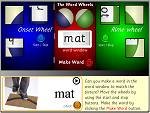Help Your Child Improve Auditory Skills by Teaching Alphabet Letter Sounds
In order to read, every child must know the sounds of the alphabet letters. He must be able to recall them quickly - he sees the letter and says the sound without hesitation.
- Test your
child's knowledge of alphabet letter sounds by using the provided Alphabet List. Point to
each letter and ask your child to, "Tell me what this letter
says."
*The alphabet list has no pictures, so your child has to rely totally on memory.
*You are asking your child to tell you the letter sound, not the letter name.
*Write down letter sounds that he or she misses. This is a good place to begin fixing your child's auditory gaps. - If your child needs to learn most of the alphabet letter sounds, help her create her own Alphabet Book. Staple some pieces of paper together and ask your child to draw pictures of items that begin with the sound of each alphabet letter.
- You can also
teach alphabet letters and letter sounds by using an Alphabet Chart with
pictures.
*Be sure to point to each letter as you are saying the letter name and letter sound.
*Review the alphabet chart once a day and pretty soon your child will be able to point to each letter and say the sounds himself!
*I have an alphabet chart tacked on the wall at kid-height of my son's bedroom so he can look at it. - When you are teaching a letter sound, be careful not to add an "uh" sound at the end of the letter. For example, letter s should sound like a snake hissing, with no throat sound. Letter s says 'sss,' not 'suh.' If your child learns letters 'c', 'a', 't' as sounding 'kuh,' 'aah,' and 'tuh,' those sounds will not come together to say cat!
Children have different learning rates. Your child may need lots of direct instruction to learn the alphabet sounds. Don't forget, he will learn letter sounds more quickly with a short daily review.
 Letters and Sounds Phase 2 Initial Sounds Match
Letters and Sounds Phase 2 Initial Sounds Match Sound Sea
Sound Sea Letter Lifter
Letter Lifter Phoneme Pop
Phoneme Pop Word Wheel
Word Wheel Reading machine
Reading machine Three-letter house
Three-letter house Starfall
Starfall DJ Cows
DJ Cows Phonic Fighter
Phonic Fighter CVC Maker
CVC Maker